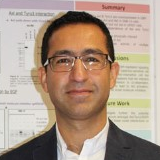Receptor Tyrosine Kinases
A special issue of Cells (ISSN 2073-4409).
Deadline for manuscript submissions: closed (15 November 2013) | Viewed by 117247
Special Issue Editor
Interests: epigenetics; focal adhesion proteins; receptor tyrosine kinases; cell signalling; vitamin K; cancer; myelin; multiple sclerosis; brain tumours; renal carcinoma; cytoskeleton; cell migration
Special Issues, Collections and Topics in MDPI journals
Special Issue Information
Dear Colleagues,
Since the earliest discoveries of growth factors in the 1950s and of transmembrane receptors for these factors that possess protein tyrosine kinase activity in the 1970s, the body of knowledge on receptor tyrosine kinases (RTKs) has increased appreciably. The uniqueness in structure and ligand-binding specificities of the ectodomain of RTKs determines their subclassification, and today we know of the existence of around 20 different RTK classes, with a number and diversity of ligands that is ever increasing. Despite this diversity, RTKs continue to together represent a major group of molecules that play important roles in both health and disease. Normal RTK function is associated with development, cell and tissue growth and differentiation and cell-cell and cell-matrix interaction, whereas RTK overactivity and/or overexpression is a common feature in many cancers. However, novel aspects to RTK structure and function are increasingly becoming apparent as more research is being done. Amongst these include ligand-dependent and -independent mechanisms of activation, alternative and unexpected receptor clustering patterns, spatial and temporal control of RTK signalling, intracellular RTK functions, RTKs as entry gateways for pathogens, and as highly attractive candidates in target-specific cancer therapy. The aim with this Special Issue of Cells is to offer an Open Access collection of scholarly reviews on the forefront of research on RTKs that covers all of the above aspects and more. We hope to provide a stimulating resource that will inform the student and the academic on the breadth and diversity of RTK biology. This is a field that is sure to maintain a high level of interest and research activity from both academic and industrial sectors with interests in science and medicine well into the future.
Dr. Sassan Hafizi
Guest Editor
Manuscript Submission Information
Manuscripts should be submitted online at www.mdpi.com by registering and logging in to this website. Once you are registered, click here to go to the submission form. Manuscripts can be submitted until the deadline. All submissions that pass pre-check are peer-reviewed. Accepted papers will be published continuously in the journal (as soon as accepted) and will be listed together on the special issue website. Research articles, review articles as well as short communications are invited. For planned papers, a title and short abstract (about 100 words) can be sent to the Editorial Office for announcement on this website.
Submitted manuscripts should not have been published previously, nor be under consideration for publication elsewhere (except conference proceedings papers). All manuscripts are thoroughly refereed through a single-blind peer-review process. A guide for authors and other relevant information for submission of manuscripts is available on the Instructions for Authors page. Cells is an international peer-reviewed open access semimonthly journal published by MDPI.
Please visit the Instructions for Authors page before submitting a manuscript. The Article Processing Charge (APC) for publication in this open access journal is 2700 CHF (Swiss Francs). Submitted papers should be well formatted and use good English. Authors may use MDPI's English editing service prior to publication or during author revisions.
Keywords
- receptor tyrosine kinases
- growth factor
- signal transduction
- phosphorylation
- spatial and temporal signalling
- tyrosine kinase domain
- transmembrane domain
- RTK class
- dimerisation
- docking protein
- development
- differentiation
- cancer
- monoclonal antibodies
- small molecule inhibitors
- anti-cancer drug resistance
Benefits of Publishing in a Special Issue
- Ease of navigation: Grouping papers by topic helps scholars navigate broad scope journals more efficiently.
- Greater discoverability: Special Issues support the reach and impact of scientific research. Articles in Special Issues are more discoverable and cited more frequently.
- Expansion of research network: Special Issues facilitate connections among authors, fostering scientific collaborations.
- External promotion: Articles in Special Issues are often promoted through the journal's social media, increasing their visibility.
- Reprint: MDPI Books provides the opportunity to republish successful Special Issues in book format, both online and in print.
Further information on MDPI's Special Issue policies can be found here.






